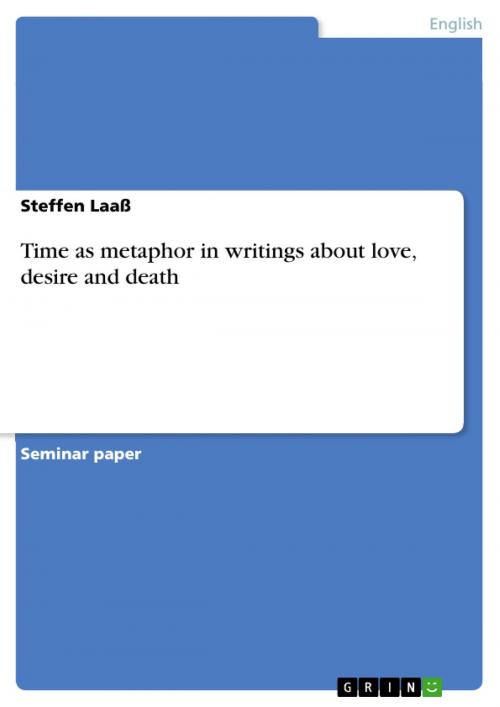Time as metaphor in writings about love, desire and death
Fiction & Literature, Literary Theory & Criticism, British| Author: | Steffen Laaß | ISBN: | 9783638616461 |
| Publisher: | GRIN Publishing | Publication: | March 20, 2007 |
| Imprint: | GRIN Publishing | Language: | English |
| Author: | Steffen Laaß |
| ISBN: | 9783638616461 |
| Publisher: | GRIN Publishing |
| Publication: | March 20, 2007 |
| Imprint: | GRIN Publishing |
| Language: | English |
Seminar paper from the year 2005 in the subject English Language and Literature Studies - Literature, grade: 2,0, University of Nottingham, course: Early Modern Love, 10 entries in the bibliography, language: English, abstract: 1. Introduction The Renaissance was an exciting age. It was a time of exploration and discovery. People were eager for knowledge and keen on unravelling fundamental mysteries that make up their existence: What is Man? Which position does he take in the universe? What is he there for at all? Why is life so short? What is love? Without generations being so inquisitive and inquiring, human progress would have come to a standstill. Luckily, people increasingly became aware of the fact that they are an integral part of nature's changing course and controlled by an external force which is far beyond their power: time. In this essay, the concept of time is of utmost interest. It shall serve as a microscope to examine literary and theoretical writings that deal with such fundamental issues like love, desire and death. Their readings are presented from a fascinating angle where time functions as a metaphor. To this end, three core texts will be explored: William Shakespeare's tragedy Romeo and Juliet and his narrative poem The Rape of Lucrece, and Sigmund Freud's Mourning and Melancholia. Before we embark upon a 'metaphorical reading', I present an interesting framework that will come in useful when we investigate the texts. First, we study the relationship between time and metaphor. 2. Metaphorizing time Let us imagine an elderly long-bearded man dressed in a robe. He is bald, but he has a forelock of hair. With him, he carries a scythe and an hourglass. Sometimes he is depicted cradling a baby in his arms ... This mythical figure is commonly known as Father Time. This example vividly shows how abstract ideas like that of time lose their obscurity and become more apprehensible by means of personification. However ungraspable the notion of time may be, personifying facilitates the determination of time's typical features on a non-abstract level. I must note at this point that, in this essay, I will not draw a distinction between the concepts of personification and metaphor because I regard personification as the ultimate metaphor achievable. When we are able to personify something, the abstract becomes us, like us - and it is the notion of 'likeness' upon which both personification and metaphor are based.
Seminar paper from the year 2005 in the subject English Language and Literature Studies - Literature, grade: 2,0, University of Nottingham, course: Early Modern Love, 10 entries in the bibliography, language: English, abstract: 1. Introduction The Renaissance was an exciting age. It was a time of exploration and discovery. People were eager for knowledge and keen on unravelling fundamental mysteries that make up their existence: What is Man? Which position does he take in the universe? What is he there for at all? Why is life so short? What is love? Without generations being so inquisitive and inquiring, human progress would have come to a standstill. Luckily, people increasingly became aware of the fact that they are an integral part of nature's changing course and controlled by an external force which is far beyond their power: time. In this essay, the concept of time is of utmost interest. It shall serve as a microscope to examine literary and theoretical writings that deal with such fundamental issues like love, desire and death. Their readings are presented from a fascinating angle where time functions as a metaphor. To this end, three core texts will be explored: William Shakespeare's tragedy Romeo and Juliet and his narrative poem The Rape of Lucrece, and Sigmund Freud's Mourning and Melancholia. Before we embark upon a 'metaphorical reading', I present an interesting framework that will come in useful when we investigate the texts. First, we study the relationship between time and metaphor. 2. Metaphorizing time Let us imagine an elderly long-bearded man dressed in a robe. He is bald, but he has a forelock of hair. With him, he carries a scythe and an hourglass. Sometimes he is depicted cradling a baby in his arms ... This mythical figure is commonly known as Father Time. This example vividly shows how abstract ideas like that of time lose their obscurity and become more apprehensible by means of personification. However ungraspable the notion of time may be, personifying facilitates the determination of time's typical features on a non-abstract level. I must note at this point that, in this essay, I will not draw a distinction between the concepts of personification and metaphor because I regard personification as the ultimate metaphor achievable. When we are able to personify something, the abstract becomes us, like us - and it is the notion of 'likeness' upon which both personification and metaphor are based.















